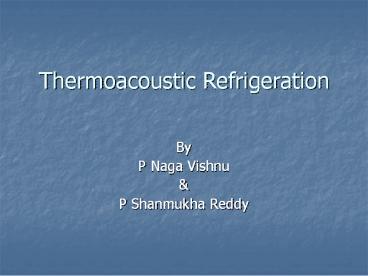Thermoacoustic Refrigeration - PowerPoint PPT Presentation
Title:
Thermoacoustic Refrigeration
Description:
Thermoacoustic Refrigeration By P Naga Vishnu & P Shanmukha Reddy Introduction Thermoacoustics combines the branches of acoustics and thermodynamics together to move ... – PowerPoint PPT presentation
Number of Views:1123
Avg rating:3.0/5.0
Title: Thermoacoustic Refrigeration
1
Thermoacoustic Refrigeration
- By
- P Naga Vishnu
- P Shanmukha Reddy
2
Introduction
- Thermoacoustics combines the branches of
acoustics and thermodynamics together to move
heat using sound. - Acoustics is primarily concerned with the
macroscopic effects of sound transfer like
coupled pressure and motion oscillations. - Thermoacoustics focuses on the microscopic
temperature oscillations that accompany these
pressure changes.
3
Basic Principle
- Thermoacoustics is based on the principle that
sound waves are pressure waves and they propagate
causing compressions and rarefactions in the
medium.
4
- In the region of compression the pressure is
high, and in the region of rarefaction the
pressure is low. - As sound waves are adiabatic in nature applying
First law of thermodynamics here we get high
temperature at compression and low temp at
rarefaction.
5
Working
6
- Sound waves of required frequency are generated
by using the loud speaker. - These sound waves are allowed to pass through the
Stack the Resonator in which standing waves are
produced. - This resonator is filled with the inert gas
(Helium) and those gas particles oscillates back
and forth parallel to the stack due to this
standing waves.
7
- By this a temperature gradient in formed along
the stack. - At the colder end of the stack heat is absorbed
from the colder surroundings and at the hotter
end of the stack heat is rejected to the hotter
surroundings. - In this way the heat is removed from the colder
body and it is maintained at required
temperature.
8
Parts of acoustic refrigerator
- There are two main parts
- 1) Driver
- - Houses the loud speaker
- 2) Resonator
- - Houses the gas
- -The hot and cold heat exchangers
- -Houses the stack
9
Description of parts
- Moving coil Loudspeaker
- Inside 2 magnets with metal coil between them,
current is induced causing coil to move - Creates sound waves up to 200 dB!
- Resonatorwhere gas cooling and compression take
place - Uses inert gas, commonly Helium
- Stack
- Series of small parallel channels through which
pressure and velocity of waves change - In between the heat exchangers
- Heat Exchangers
- Hot heat exchanger to remove excess heat
- Cold heat exchanger for refrigeration
10
Advantages
- Harmful chemicals like CFCs, HFCs, HCFCs are
not released into atmosphere. - As the working fluid is an inert gas there is no
toxicity, flammability, or negative environmental
effects. - It is more reliable as there are few moving parts.
11
Limitation
- COP is less when compared with the present
refrigerating systems.
12
Conclusion
- Thermoacoustic refrigeration is an innovative
alternative for cooling that is both clean and
inexpensive. The refrigeration effect is achieved
by using sound waves and an inert gas which will
not cause any damage to the atmosphere.
13
Thank you
14
Any Queries ???































